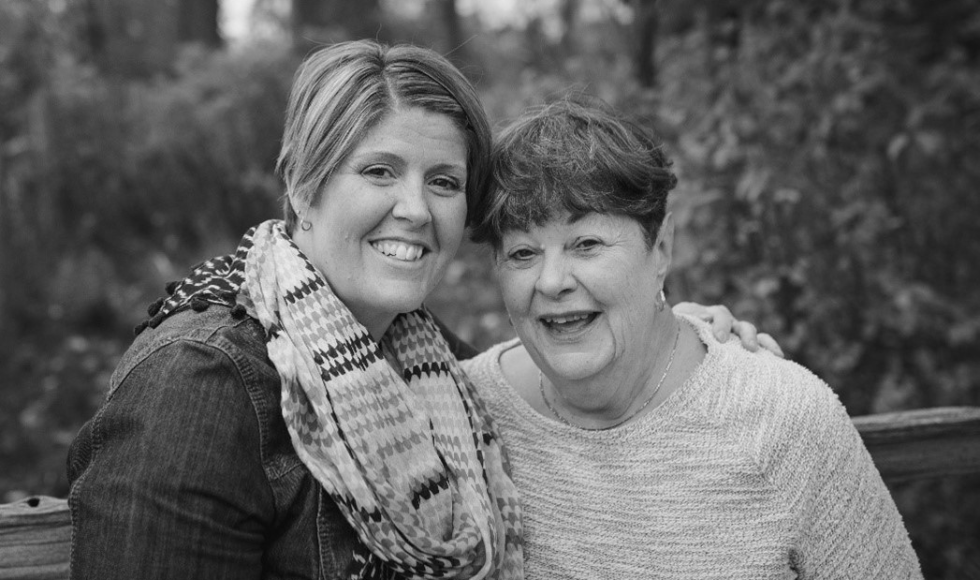The science of saving a life

For 20 years, Karin Stephenson studied medical isotopes. Then she saw their impact when they helped save her mother’s life.
BY Jesse Dorey
September 26, 2024
It’s early September, and Karin Stephenson is watching crowds of students on campus from her office window, many of them unaware they’ve just walked by a nuclear reactor.
Stephenson, the director of nuclear research and education support at McMaster University, is getting ready to talk about how medical isotopes are used to diagnose and treat cancer.
She begins with the story of how these tiny particles saved her mother’s life.

“It’s easy to talk about my mom,” she says with a laugh. Stephenson talks about her mother’s spirit — her strength, her generosity, her kindness. “She’s just somebody I really look up to.”
Ten years ago, Dianne Stephenson was diagnosed with Stage 2 melanoma, a form of skin cancer. “My mom is a warrior, and she really is the figurehead at the top, so her diagnosis was a huge shock for our whole family,” recalls Stephenson.
And there was another shock in store.
Stephenson asked her mother’s oncologist to perform a positron emission tomography (PET) scan, which uses medical isotopes to scan a patient’s body to detect diseases such as cancer.
PET scans are not a standard procedure for patients with melanoma, but Stephenson, a nuclear scientist with decades of experience in radiopharmaceutical chemistry, knew the additional scan might be a good idea.
The PET scan revealed that Dianne also had an aggressive form of breast cancer. Had they not discovered it so early, it likely would have been fatal, says Stephenson.
A decade later, Stephenson recalls what she went through with her family that day. “I think you go through stages of grief — I was mad, then I was sad, then I was worried,” explains Stephenson. “My mom is such an integral part of our family, and my kids are so close to her, I couldn’t imagine having this conversation …”
She trails off for a moment then collects her thoughts and smiles.
“Medical isotopes really do give us hope. I truly believe the PET scan saved my mother’s life.”
Karin Stephenson receives John B. Little Legacy award for innovation in radiation sciences
Going nuclear on cancer
But what are medical isotopes? And how do they work?
Medical isotopes, or radioisotopes, are radioactive particles that have been used for decades in diagnostics like PET scans to detect cancer and other diseases.
And in recent years, scientists have found ways to use medical isotopes to kill tumours and treat cancer.
Learn more about McMaster’s leadership in medical isotope research and production
Here’s how it works.
Medical isotopes can be broken down into two main uses: diagnostic and therapeutic. Diagnostic isotopes, such as fluorine-18, when incorporated into a targeting biomolecule can detect cancerous tumours in the body, and therapeutic isotopes, such as iodine-125, are deployed to kill these tumours.
Naturally, the process begins with a diagnosis. At this stage, an irradiated isotope is attached to another molecule, called a targeting agent, to create a radioactive tracer. In the case of fluorine-18, the isotope is attached to glucose to make flurodeoxyglucose, or radioactive sugar. This is injected into the patient and travels through the body, identifying cancerous growths. A short time later, these tumours show up as black dots on diagnostic scans, indicating where the cancer is.
Now, treatment can begin.
And this is where therapeutic isotopes enter the picture.
Take iodine-125, a radioisotope typically used in radiation treatment of prostate cancer. The isotope is embedded into a tiny “seed” about the size of a grain of rice. When treatment starts, that seed is planted into and around the tumor, delivering a concentrated, targeted dose of radiation that kills the cancerous tumour while keeping the healthy tissue around it alive.
Scans and treatment can be repeated until the tumour is eradicated.
From the core to the clinic
“McMaster’s really special in the field of radiopharmaceuticals,” says Stephenson. “We have a research reactor, we have a cyclotron, and we have this high-level lab facility that allows us to go from the nuclear reactor core to clinic.”
Celebrating 65 years of research and innovation at the McMaster Nuclear Reactor
The unique core-to-clinic model begins with the irradiation of an enriched isotope. This happens generally in either the cyclotron (a machine used to make short-lived radioactive isotopes) for diagnostic isotopes, or the reactor for therapeutic ones.
The irradiated isotope — or radioisotope — is next taken to an on-site lab and then to a clean room, where it is turned into a radiopharmaceutical.
Finally, it’s packaged and shipped to a hospital to be used in diagnosis or treatment.
A nuclear renaissance
McMaster is known for the kind of foundational nuclear research that continually expands the horizon of how these isotopes might be used. It has done so for decades, and Stephenson can tell the future will only get brighter.
“I think there are going to be new treatment options for cancers that we currently have nothing for,” she says.
“I think we’re going to do better with the cancers that we already know how to treat. And I think some of our sickest patients are going to have hope — for longevity, for more time.”
After a decade of rapid growth, work in radiopharmaceuticals is showing no signs of slowing down.
Recently, McMaster partnered with Terumo and AtomVie Global Radiopharma Inc. to produce QuiremSpheres™, a medical device that uses holmium-166 to treat liver cancer and improve personalized care for cancer patients.
Meet John Valliant, the scientist-entrepreneur behind one of the largest acquisitions in Canadian university history
Fusion Pharmaceuticals, a company founded by McMaster researcher John Valliant, develops next-generation cancer therapies that are targeted, personalized and more effective than traditional cancer treatments.
Earlier this year, AstraZeneca acquired Fusion for $2 billion (US), making it one of the highest-valued acquisitions of a Canadian university spinout company.
When the stars align
The tables and cabinets in Stephenson’s office bear framed reminders of major moments in her career. Photos of her children are pinned to a corkboard beside her.

The walls are lined with science-themed prints. One reads, “Science: It’s like magic, but real.”
“I’m a scientist, through and through,” she says. “But I do believe that sometimes things are just aligned and you’re supposed to get the information when you get it, however that is, because you just never know.”
Update: Dianne was cancer-free for more than seven years until earlier this year, when doctors found a recurrence of breast cancer. After a recent surgery, there are no further signs of cancer in her lymph nodes, and her prognosis is good. She is now under the care of her oncologist.


